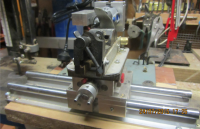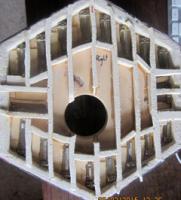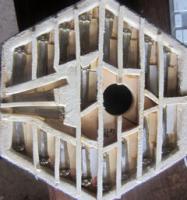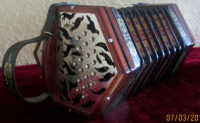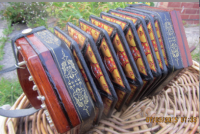
David Hornett
Members-
Posts
234 -
Joined
-
Last visited
Everything posted by David Hornett
-
I have made equal amount, 5 inset and 5 flush, simply by mistake (I cut 10 lots of bellows cards to length and then not thinking reduced the concertina frame to 6", too lazy to recut the bellows cards (I did not discover my mistake until I had begun making one of the bellows) I fitted one, seemed fine so now have 5 flush bellows. No noticeable difference in performance, but the bellows are not as protected when the instrument is put down. David
-
5-Fold Bellows On An Anglo
David Hornett replied to Daddy Long Les's topic in General Concertina Discussion
Hi Les, I have made 5, 6, 7 and 8 fold bellows for 3 row anglos. My Jones has 8 fold and it developed a rather open bellows playing style, hands apart, which I have to be aware of if i am playing on lesser fold instruments. The Jeffries has 7 fold, and they seem just right for my straight along the row style, with an attempt to walk the bass (I am not a particularly good player). The Lachenal has 6, and sometimes I find myself just about to run out of air, especially if I play the bass, another Lachenal with 5 folds, the first set of bellows I ever built, does run out of air, especially if I touch the bass, and is a real menace. My advice, especially if you play in the set keys straight along the rows (not across in the Irish style) is no less than 6 folds. (I have sat is sessions with some pretty nifty Irish players who barely seem to move the bellows, while I am pumping like an air gulping guppy ... it all in the style, and if you are an old accordion player who 'omph cha's' the bass a lot of air is used) David Hornett- 19 replies
-
- Daddy Long Les
- 5-fold bellows
-
(and 1 more)
Tagged with:
-
Action Board Holes Flare Out. Why?
David Hornett replied to Jody Kruskal's topic in Instrument Construction & Repair
Hi, I have a 44 button jeffries, D/G, it also has flared holes, worse than yours. The reason being that the holes are outside the chambers and have to be tapered in. They are only the middle chamber holes, not on the outside, and there is insufficient room to fit the reeds and mechanism above if they are not flared. The start of the hole being outside the chamber, the end in the chamber. The 44 note Jeffries has a thicker action board. This may be the same with your instrument. David -
Yes Malcolm, I was considering bidding; then on a closer look the name seemed different in impression, somehow more scratched than stamped, even allowing for the corrosion, the letters appear distorted. In fact, the bellows have been both replaced and repaired if one considers the bindings and the lack of decoration, and from what can be seen of the papers, none there either of Jeffries' livery. The buttons seem to sit rather high suggesting complete lack of pads, the strap screws are different end to end. The fretwork, although in the Jeffries form is slightly less delicate, and then there is that air button escutcheon. So I wonder, but not enough to bid, hesitating to think if the reeds are Jeffries, if indeed they are there at all. David
-
Anyone? When the max 4MB image limit is reached is one barred from uploading for ever, or is there a time limit? David
-
Screws For Insert / Nut For Wrist Straps
David Hornett replied to RWL's topic in Instrument Construction & Repair
This fellow, Brass and bronze fasteners (Queensland) , sells everything a small screw man desires and at very reasonable prices: http://www.bronzeandbrassfasteners.com.au/#siliconbronzeandbrassfasteners David -
Lachenal And Wheatstone Thumbscrew Threads
David Hornett replied to RWL's topic in Instrument Construction & Repair
Yes, Nickel Silver will discolor and tarnish, but certainly not at the rate of brass. The material I use is C75720: Copper 60-65%, Nickle 11-13%, Zinc 21-28%, and preferably C792: 18% nickle. This is used for buttons and end plates. The best way to maintain the shine is not with wax, but buff to a high luster, soak in vingar and water 50/50 for half an hour or so, dry without touching, and then coat with a polymer car polish (NOT WAX) Nu Finish is an excellent polish for this. Bolts made from Nickel Silver are certainly gummy to machine, but if you use the tailstock method for threads are no problem at all. For buttons, use a parting bit ,HSS, ground to 3/32 wide slight spade tip and spin at approx 2400 RPM. Buff with a rag buff and cutting compound, coat with ploymer and the finished product is a joy to behold. David -
Lachenal And Wheatstone Thumbscrew Threads
David Hornett replied to RWL's topic in Instrument Construction & Repair
You need nickel silver (German silver) seems pretty robust when it comes to verdigris. I have made 10 or so in the above mentioned manner from half hard brass, then milled the middle out to1mm depth, dropped in a small bead of resin solder, fly punched a nickel silver disk out of 1.62 sheet and tapped it in the end, while heating the screw. When cooled then turned down to 1mm at the sides with a small convex, (1.62 in the middle) has a great effect when polished and is fairly easy to do. David -
Lachenal And Wheatstone Thumbscrew Threads
David Hornett replied to RWL's topic in Instrument Construction & Repair
My thumb screws are cut from a single brass off cut (found at engineering works, or on ebay, 'brass rod'). I have made housings to hold the die in the tailstock and press against the rod, held in the chuck, when spun down to size, after which I knurl the head. Holes are also tapped by the same method when I make the nuts to be seated in the casing under the straps. These nuts are not off centre, rather they pressfit and a piece of 1 mm brass rod 3/8th long is run through their casing and the concertina end and snibbed off. All my concertina screws are made in the same manner, driving them through one of these dies held in the tail stock. I attempted to forward a photo but have used up all my allowance. If interested send an email and I will forward. When I repair thumb screws I make new ones and nuts using M3 x50 thread David -
Reed Shoe Thickness
David Hornett replied to David Hornett's topic in Instrument Construction & Repair
Thankyou Dana. My G5s are 17mm. I think it is just poor profiling and I am reforming my wicked ways. I tried to upload three JPGs, but too big so just one at reduced quality. I shall attempt to find your email address and send them that way. All the best DAvid -
Reed Shoe Thickness
David Hornett replied to David Hornett's topic in Instrument Construction & Repair
Thank you Dana, The reed shoes are lazer cut, and so the cut edges are work hardened, but following your advice I'll undercut these windows, as I have already with the brass reeds for the other instruments. I have managed to get the tongue clearance on my others down to between .03 and .04mm, although the profile has caused some headaches, seems that G5 have objections to it, the only reeds that have broken after 10 hours or so are the G5s (3 of them), so I have taken to reducing the shoe lengths for these, so far seems to have worked. Yes the crimping in the pans may cause some problems over time, however I am hoping that my slightly wider frames and the pans being made from the very oily huon pine will negate this. The milling jig is a dremel 3000 with a tungsten carbide mill bit laid on its side. The vice and carriage are fitted to lineal bearings. The reed is crimped in a 7degree angled vice and adjusted against a gate to get the cutter parallel and after a couple of passes the sides have been cut, can whip through 78 reeds in about an hour. Took me longer to make the mill than the concertina. I could mill the windows on the larger shoes with the same jig, but it all becomes so fiddly that it has been much quicker to file them. Again, thank you so much for your help. David -
Reed Shoe Thickness
David Hornett replied to David Hornett's topic in Instrument Construction & Repair
Thank you Dana. Why I ask is because I have had my lever posts cut from titanium, with pivot holes and a small hole in the base for the spring foot, rather than nesting the springs in the wood (The last 4 instruments I stamped them out of nickle silver rod, but decided a weight reduction would be nice, so titanium) With the left over 1.62mm metal I had 5 shoes cut in each of my eleven shoe sizes, just enough for a 3 row with a few big 2mm brass reeds. I have made a little milling jig to cut the rebate taper on the sides to slip into the shoe plate (I made it for the brass shoes and it works just fine on the titanium too) but I very much doubt any file can touch the work hardened reed slots, I have tried and it is hard work, hence my question, which can be read, "Should I bother?. So, thank you for your answer. PS: The titanium is fractionally under half the weight of the same note in half hard brass, and I notice that working the brass with the milling jig to grind the side tapers, noticeably tempers it to a rather hard substance. David -
Hi, Has anyone out there in concertina land experimented with shoe thickness. My shoes are currently 2mm, but if I made them say 1.5mm would the tone change, possibly negating the need to undercut the reed, at least to the same degree? I could do some tests, but hopefully someone has beaten me to it. All the best David
-
AH, yes, get the right dia, brass bar: approx 15mm across, Tool down to the right dia for the threading die, (approx 10mm of thread. Lock the die in the tailstock, or hold it by the hand tool With model still in chuck cut the thread using the lathe to turn the model through the die (The thread does not need to go all the way because there is also the lather which sits on a collar.) Knurl the other end of the bar. Part off. I made my first half dozen from an old brass bearing drift. Hope this helps David
-
Ebay Two Row Jeffries/crabb
David Hornett replied to David Hornett's topic in General Concertina Discussion
Thank you Stephen. A Shakespeare would not be a bad instrument, in fact if the problem had not been pointed out she may have merrily gone on to the end of her playing days believing the lie, about as bad as believing a Crabb or a Jones to be a Jeffries I would suggest, and it seems that lie runs rampart amongst players. Thank yuo for your input, I have found the discusion fascinating. Thankyou David -
Ebay Two Row Jeffries/crabb
David Hornett replied to David Hornett's topic in General Concertina Discussion
Thank you for the link Stephen. In scouting further around Concertina net I read an entry reporting that the Dippers had come across a George Jones with Jeffries Maker stamped on it. Hmm, seems the great Jeffries may not have been quite as great as has been implied. All the best, David -
Ebay Two Row Jeffries/crabb
David Hornett replied to David Hornett's topic in General Concertina Discussion
Thank you Alex, No stamp, either side or front, so it seems as though you did not miss out on a Jeffries. I have put a few of the reeds over the bench and compared them with some spare Jeffries reeds I have in the same pitch: absolutely no difference, so, seems it's all in the name./ If you wondered what my top bid was going to be rather than what it was, 500 pounds ($1000 Aussie dollars) came in at half that. Keep me busy for a week or two making bellows and cutting frets. (Maybe I should make a Jeffries stamp, if that is really all the great man did himself, sort of keep up the tradition one would think???) Thank you again everyone. David Hornett -
Ebay Two Row Jeffries/crabb
David Hornett replied to David Hornett's topic in General Concertina Discussion
Were all Crabbs numbered? The two Crabbs that I have repaired were both numbered. The two Jeffries I have and the instrument I am now wondering about is not. Is it possible to determine their genisis in this manner do you think? Does anyone know?(I suspect I can guess at the answer and possibly will have to leave it with Stephen's: so they're only "Jeffries" if they're stamped, and I'd call 'em "John Crabb" if they aren't...) David -
Hi all, I was the winning bidder on the Jeffries/Crabb two row you may have seen on ebay a few weeks back. The reeds are in unfiled excellent condition, no rust, still in old pitch, all working untouched, in fact the instruments is very clean inside (The inside is so unmarked and clean, it looks like it has gone through a washing machine). But, as could be seen on the ebay images, the bellows are totally disintegrated, and the fretted ends will need recutting, but otherwise everything is there to make job fairly straight forward. But can anyone help me? I have two Jeffries with metal ends stamped Jeffries Maker and Jeffries Bros. Did the wooden ones have this stamp too? The one I purchased, although in Jeffries livery, and fretted end design, does not. I ask because the reeds and shoes are exactly the same, in measurement as the 1880/90's Jeffries and the 1920's Jeffries I have. The reeds are immediately recognizeable as they tend to be slightly slimmer with thicker shoes than the Lachenal, in fact a Lachenal I did up a few years ago had a lone slim C4 reed packed in with sheets of folded brown paper, a little longer in slot than a Lachenal, and I would swear it was a Jeffries. The bellows cards are of the same dimensions as the bellows cards of the early jeffries I did up, and the reed plate is the same thickness, much thicker than a Lachenal. The valves are parallel, not saddle punch shape, as on Jeffries, and the pivot pins are the same as Jeffries. So I wonder, were non-stamped Jeffries always Mr Crabs efforts, or were they simply unstamped Jeffries, OR will one never know? (There is no number inside the instrument) Any advice? (Anyway, when I am finished it will be a beautiful two row, to all intents and purposes a Jeffries, but without the mark, just the way it was sold. A very happy purchase for me.) Best regards to all, David Hornett
-
Peter introduced me to the concertina, in fact to the whole folk scene. Among a multiplicity of other activities related to Australian music and dance, he was a fixture at the Nariel Creek Folk Festival where he called the old time dances, played for hours on concertina, accordeon, whistle, harmonica and the occasional stringed instrument. He was absolutely inclusive of everyone, good musicians, beginners, and those inbetween. His laughing mirth, his wit, his absolute zest for all things Australian folk and total commitment to his friends will be very sadly missed. We were so lucky to have Peter amongst us and this year at Nariel, and all the other places dancers and folkies gather, there will be a sadness, but also a recognition that but for Peter and his efforts many of the tunes played, the dances danced and the proliferation of folk instruments playing that music, would not exist. A true gentleman who has made an incalculable contribution to Australian folk music and traditional dance, a superb folk musician never short of a merry tune impeccably played in the Australian style and a man who personified the joy, community and friendship that comes from dancing and playing music together. And a prolific author who has ensured that through his writings and especially his collected music out tradition will live for years to come. A very great loss for us all, and we can be sure there will be at least one concertina player in heaven. David Hornett
-
Tassie Tiger C/g Reed Pans
David Hornett replied to David Hornett's topic in Instrument Construction & Repair
Agreed, Alex, and I learnt it the expensive way. David -
Tassie Tiger C/g Reed Pans
David Hornett replied to David Hornett's topic in Instrument Construction & Repair
Jake, thank you for your compliment. Rectangular strip like the 'Broad reed Jones', of 1880 but 10% wider across all reed tongues. No low reeds required weighting (although 1 did so on the DG I made a while back). I am very pleased with the sound. The hardest part was replacing files, a bit rough on the pocket, after experimenting with some expensive, 2nd cut Valtitan Swiss files, which barely scratched through 50 reeds I discovered the Nicholson 2nd cut, made in Brazil (and also in Mexico), the cheapest file in the shop and by far the best. So one does not necessarily get what one pays for in files, it seems.. David -
-
What our concertinas look like?
David Hornett replied to new english's topic in General Concertina Discussion

